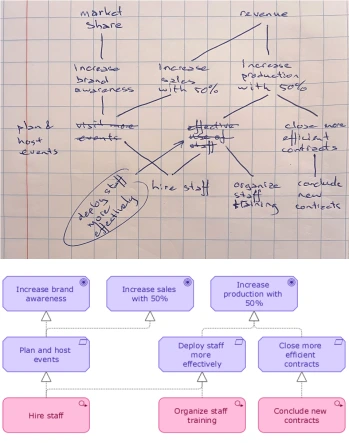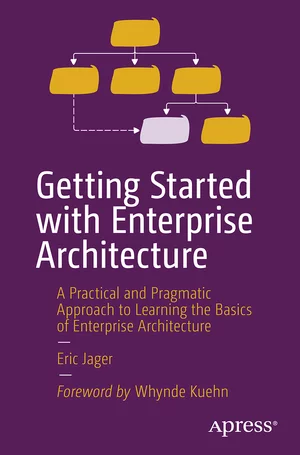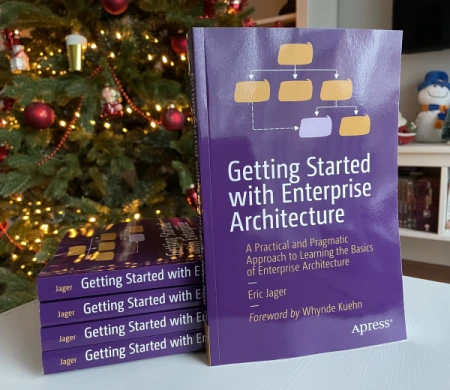My book Getting Started with Enterprise Architecture is now in stores. A sentence I never thought I would be able to utter a few months ago. When I started writing my book in early 2023, I never dreamed that I would be holding a physical copy in my hands just 11 to 12 months later. Read on to learn more about an author’s journey.
How it all started
The winter of 2022-2023 was still in full swing and the evenings were long and dark. This turned out to be an excellent time to pick up the proverbial pen and start writing down my thoughts and ideas about the field I love and have been practicing for over 15 years: Enterprise Architecture.
Over these years, I have had the opportunity to work for several different organizations and have been able to develop a complete, but also broad and comprehensive picture of what Enterprise Architecture is and what it means to organizations. And perhaps more importantly, what it does not mean to them.
I have tried to translate this picture into an implementation framework that organizations can use when they have expressed the desire to start working with architecture. Using a self-created Enterprise Architecture Implementation Wheel, I have developed a method that can be used to implement a basic Enterprise Architecture.

The focus of the Implementation Wheel is really on the basics. There is, of course, much more to describe and to detail in the context of Enterprise Architecture. However, my idea was to start with the basics, and to provide a solid foundation upon which organizations can build.
In my opinion, the existing frameworks such as the Zachman Framework™ and the TOGAF Standard® provide excellent guidance, but the frameworks describe the method too much from a theoretical point of view. The practice in organizations is often more recalcitrant. Therefore, my Enterprise Architecture Implementation Wheel translates the order of existing methods from the frameworks in a slightly different way. This creates a more practical application of the theory without compromising the methodology.
The creative process
Writing a book is not an easy task. Before I put my pen to the paper, I spent a lot of time just thinking about what to say, and, more importantly, what not to say. This alone took me several long evenings. Gradually, topics that I initially thought were necessary were dropped and vice versa; topics were added to the book that I had not previously expected to include. It was a daunting task to establish the bare essentials without undermining the theory of existing frameworks. Nevertheless, I have arrived at a solid baseline, and I am convinced that what I have described in my book can be counted among the foundations of Enterprise Architecture.
Foreword
Before I started writing my own book, I read a lot of literature about my field. I wanted to get a complete picture of everything there is to say. In addition, reading what other authors had to say about certain topics helped me to create a mix of what I found interesting and what I did not. While reading these many books, I came across the book Strategy to Reality by Whynde Kuehn. Her writing style appealed to me and the way she managed to articulate a somewhat difficult subject like Business Architecture inspired me greatly. It did not take long for me to realize that I wanted Whynde to write the foreword to my own book.
I contacted her and we got to know each other a little better through various emails. We also arranged a short interview. Both parts of the interview have since been published on my blog (Part 1 and Part 2 of my interview with Whynde Kuehn). Whynde was more than willing to collaborate on the foreword and managed to put together a great story. An excerpt of the foreword can be viewed on my website.
Submitting the manuscript
After I completed my manuscript, I wrote to three publishers. These days, all publishers have online book proposal forms with a variety of questions they want you, the author, to answer. I filled out such a form for three publishers, trying to be as complete as possible. The publishers were selected based on their portfolio. Unfortunately, two of the three publishers never got back to me. On the upside, it only takes one to consider the book publishable, and that turned out to be Apress.
Once I submitted the online form, the wait began. All the publishers notified me that it would take them at least two to six weeks to get back to me. In reality, the wait was actually much shorter than I expected. Within two days I received word from Apress that they were interested in publishing the book. They had a few additional questions, but overall the interest was serious. After I answered the questions, I didn’t hear anything for about a week and a half. But then the answer came: the publisher was definitely interested and wanted to work with me to publish the book!
The contract
Shortly after submitting the manuscript, I received the contract. The purpose of such a contract is to clarify mutual expectations for both parties. In addition to the usual legal language about your obligations as an author, it also mentions things like the agreed-upon dates for submitting chapters and when the complete manuscript should be ready. In my case, the manuscript was already complete when I contacted the publisher.
What is also included in the contract is the royalty agreement. Royalties are a percentage of the sale price of the book. There is a standard percentage for the first 2000 copies. Should the book sell more copies, the percentage increases. Of course, there is a maximum to this. If you write a book about my field of expertise, you should not have the illusion of becoming as rich as the famous author J. K. Rowling of the Harry Potter series. The circulation of books in my field is nowhere near that of books in the popular young wizard’s series. My goal in writing the book was to provide concrete, actionable tools for implementing Enterprise Architecture.

Designing the cover
As for the cover, nine times out of ten, the publisher determines the cover of the book to be published. At least in the case of books about a specific field, such as architecture. Often the publisher has a standard template that is used for books in a particular series. However, Apress was willing to cooperate and allow me to use and design my own cover.
Although you might not think so at first glance, there is a (short) story behind this cover. Take the color purple, for example. This color was chosen because of its relationship to the word and theme of strategy. Since Enterprise Architecture is primarily a strategic business management tool, the color purple seemed appropriate to me. It emphasizes the primarily strategic aspect of the field.
The color yellow was chosen for two reasons. First, it is a deliberate nod to the publisher. It is a token of thanks for wanting to publish my book. In fact, Apress themselves use the exact same yellow color for the covers they design. On the other hand, the color yellow refers to the fictional company called Lemon-A-de, which I used as an example for implementing Enterprise Architecture using the methodology described in my book. The color white was chosen for no particular reason. It serves only as a contrast color and stands out well against the purple background.
The review process
After submitting the chapters as separate documents to the publisher, the review process began. I was able to work with Rob Malschaert who, based on his knowledge and expertise of the subject matter, was able to evaluate the content of the book for both accuracy and completeness. I carefully reviewed Rob’s comments and made adjustments to the book where I felt it was necessary.

Frankly, it makes perfect sense to have an outside party, in this case the reviewer, look at the story. Such a person will pick up on some imperfections that you, as an author, are too quick to overlook during the writing process. For example, there was one situation where Rob did a good job of pointing out that there was a continuity problem. This had to do with the fact that the chapters were not written in chronological order, so in one case the continuity seemed off. Fortunately, I was able to correct this based on Rob’s feedback.
The editing process
Once the review round was over, the editing process began. This process involves sending the introductory pages (think introduction, foreword, and acknowledgments), chapters, and reference lists to the editor. The Editor (or editors) is responsible for the copyediting process. During this process, the proverbial i’s are dotted and t’s are crossed. For example, they make sure that the correct headings are used in the chapters. The final layout and formatting are also taken care of. At the end of the copyediting process, I received a proofing copy, which allowed me to make some final adjustments. Being able to see the book in its almost finished form was very satisfying because it looked really good. The book then went into the publishing process and was published December 2nd, 2023.

Receiving the books
On December 12th, 2023, the time had finally come. I received five complementary copies from the publisher. It was a very memorable moment to receive the final result after months of hard work on the book.
Writing my first book was an extraordinary journey. I have enjoyed every moment and it was very satisfying to hold the physical books in my hands.
Obviously, I am very curious about feedback on the book and look forward to hearing about it. Be sure to let me know what you think of it by leaving a comment below. You can also use the contact form to send me a message.
Getting Started with Enterprise Architecture is available from:
Amazon | Barnes & Noble | Springer | Bol | Managementboek







Leave a Reply